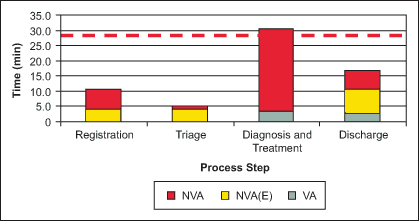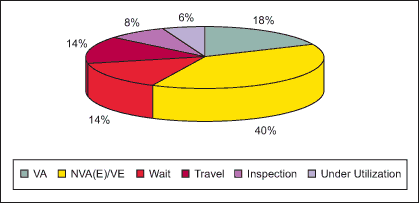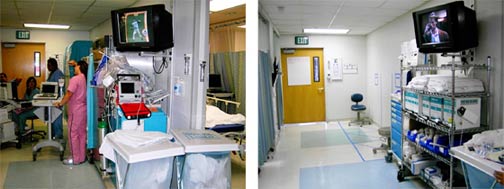
Sharp Chula Vista Medical Center is a 330-bed hospital with one of the busiest emergency departments in San Diego County, California, USA. In 2005, the wait time for emergency department (ED) patients had noticeably increased, driven by a growing demand for services, combined with staffing and space constraints. To identify bottlenecks, the ED manager and staff performed a process review and sought help from Sharp Healthcare’s Lean Six Sigma process improvement department on a project to improve patient flow through the department.
Lean and Rapid Medical Evaluation
The rapid medical evaluation unit, or RME, is responsible for treating 30 to 40 percent of all ED patients at Sharp Chula Vista. It was established to help manage less urgent cases door-to-door within 60 minutes. After implementing RME, wait times initially went down and patient satisfaction went up.
With subsequent population growth, however, the department saw a rise in RME wait times. Selecting patients to be treated in the RME had become dependent on provider availability rather than standardized processes. Also, physician assistants sometimes brought moderately acute patients into the RME, causing delays and dissatisfaction among triage and RME staff. Pressures arose for the RME staff to treat patients in alternate treatment areas.
To ease the situation, the hospital first addressed the physical space issue by remodeling a patient registration area located next to the RME unit. It then began to tackle process challenges by applying Lean through a Kaizen event. The situation was assessed through observation and a value stream map to understand patient flow and handoffs. As shown in Figure 1, patients were timed to measure wait time and the time they actually received care.

While this analysis quantified wait time, it did not reveal causes. The challenge was to find RME process repeatability amid variable acuity, volume and work methods. Using a special tool, a project team followed representative staff to record actions that added value to the patient, that did not add value but were necessary, or that just did not add value and were opportunities for improvement (Figure 2). This approach combined with spaghetti mapping revealed opportunities to increase efficiency while focusing on patient care.

Kaizen Event Gets Results
Prior to the Kaizen event, the project team met to validate and confirm the pre-work, provide an overview of Lean, reach consensus on goals and create an elevator speech. The Kaizen would focus on workspace organization and standardizing processes in the RME to optimize patient flow.
Observation from team members “in the process” was key, even though Kaizen leaders had already done this. Individual contributors benefited from a chance to see the overall process and the inefficiencies within their work area. The next step involved brainstorming and then actually “try-storming” improvement ideas. The try-storm method created an opportunity for instant piloting to show which solutions will work, and which need further improvement.
The Kaizen team started with a 5S activity (Sort, Set in order, Shine, Standardize, Sustain) to remove clutter and create space. Sometimes mistaken for simple housekeeping, 5S actually built a solid framework for visual management. The team introduced an RME supply cart with a drawer for commonly used medication and space for RME-specific supplies. This minimized provider travel and gave ownership of specific supplies to the RME staff.

While the 5S was under way, other team members worked through a number of complex scenarios to develop and test criteria to select patients for triage to the RME. After multiple iterations, they established a clear standard that supported the RME process targets and was accepted by the ED, RME and triage staffs.
RME provider teams were then assigned to specific patients, and clear roles were defined for the RME licensed vocational nurse and the healthcare partner. This helped assure appropriate utilization of skills while minimizing potential for errors associated with unclear hand-offs and communication gaps.
Results, Report-Outs and Sustainability
Through staff feedback and observation during the fourth day of the event, the team sought to validate the impact of the changes they had made. Some frequently used supplies were left out of the RME cart, and adjustments were made to accommodate the additional supplies. Improvements were confirmed, with a few items put on a 30-day followup plan to coordinate with construction activities. The team conducted a report-out to share lessons learned and propose future initiatives, and toured the area to experience firsthand the impact of improvements. The report-out offered a great way to recognize and celebrate success, share knowledge and build enthusiasm for Lean efforts.
The Kaizen event returned speed to the RME. It also provided an opportunity to pilot new standards using the Lean principle of Jidoka, which builds quality into the process to produce a defect-free operation. Sharp Chula Vista Medical Center now has a better method for training and tracking results, while role clarification and relocation of supplies is helping to optimize workflow. Specific Kaizen goals and sample results are included in the table below.
|
Goal |
Sample Results Metric |
| RME Logistics: Address the issues around supply centralization and workspace organization. | Moved crutches and splinting supplies into the RME treatment area. Travel reduced by 4,057 feet or .8 miles per month. |
| RME Staff Workflow: Create a visual management system to align providers to patients and reduce hand-offs. | Clarified roles, paired a licensed vocational nurse with a patient aide at each shift. Decreased time spent charting, saving about 1.5 nurse minutes per hour or 223 hours per year. |
| Patient, Family and Main ED Staff Flow: Eliminate unnecessary traffic through RME area. | Moved non-RME supplies out of the RME treatment area. Eliminated one interruption every 7.5 minutes or 40,880 interruptions per year. |
| RME Patient Selection: Standardize patient selection criteria for RME. | Initial sampling reveals a 20 percent decrease in median LOS for RME patients. Further detailed analysis indicates statistically significant improvements in median LOS demonstrated by about half the providers. |
Lean enabled the RME staff to create and sustain meaningful change in it environment. To further reduce wait time, followup efforts may target ancillary departments such as the lab, the pharmacy and radiology. Sharp Healthcare is now eyeing the next phase of it journey – moving from “point Kaizens,” a single event in a department, to “flow Kaizens,” in which events are strategically deployed along a value stream.